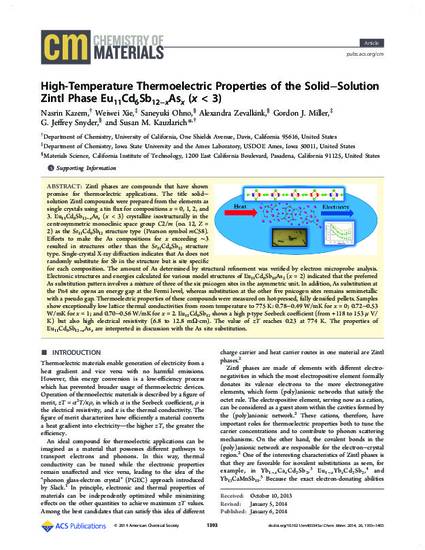
Zintl phases are compounds that have shown promise for thermoelectric applications. The title solid–solution Zintl compounds were prepared from the elements as single crystals using a tin flux for compositions x = 0, 1, 2, and 3. Eu11Cd6Sb12–xAsx (x < 3) crystallize isostructurally in the centrosymmetric monoclinic space group C2/m (no. 12, Z = 2) as the Sr11Cd6Sb12 structure type (Pearson symbol mC58). Efforts to make the As compositions for x exceeding ∼3 resulted in structures other than the Sr11Cd6Sb12 structure type. Single-crystal X-ray diffraction indicates that As does not randomly substitute for Sb in the structure but is site specific for each composition. The amount of As determined by structural refinement was verified by electron microprobe analysis. Electronic structures and energies calculated for various model structures of Eu11Cd6Sb10As2 (x = 2) indicated that the preferred As substitution pattern involves a mixture of three of the six pnicogen sites in the asymmetric unit. In addition, As substitution at the Pn4 site opens an energy gap at the Fermi level, whereas substitution at the other five pnicogen sites remains semimetallic with a pseudo gap. Thermoelectric properties of these compounds were measured on hot-pressed, fully densified pellets. Samples show exceptionally low lattice thermal conductivities from room temperature to 775 K: 0.78–0.49 W/mK for x = 0; 0.72–0.53 W/mK for x = 1; and 0.70–0.56 W/mK for x = 2. Eu11Cd6Sb12 shows a high p-type Seebeck coefficient (from +118 to 153 μ V/K) but also high electrical resistivity (6.8 to 12.8 mΩ·cm). The value of zT reaches 0.23 at 774 K. The properties of Eu11Cd6Sb12–xAsx are interpreted in discussion with the As site substitution.
Available at: http://works.bepress.com/gordon-miller/52/

Reprinted (adapted) with permission from Chem. Mater., 2014, 26 (3), pp 1393–1403. Copyright 2014 American Chemical Society.